CMAT 2026 Logical Reasoning Mock Tests: Strategies, and Sample Questions
CMAT 2026 Logical Reasoning Mock Test - CMAT Logical Reasoning is one of the important sections of CMAT 2026 examination. The Common Management Admission Test (CMAT), will be conducted by NTA, is a computer-based national MBA entrance exam in India. This exam consists of five separate sections of 20 questions each. In this article, we will discuss one of these five sections: Logical Reasoning. There are also sample CMAT 2026 Logical Reasoning Questions and Answers to help students understand this topic efficiently.
This Story also Contains
- Introduction to CMAT Logical Reasoning
- What is a CMAT Logical Reasoning Mock Test?
- Key Features of CMAT Logical Reasoning Mock Tests
- How to Access CMAT Logical Reasoning Mock Tests Online
- CMAT Logical Reasoning Practice Questions for 2026
- Strategies for Effective Preparation for CMAT Logical Reasoning
- CMAT 2026 Mock Test Series Overview
- Common Logical Reasoning Topics in CMAT
- Tips for Mastering Logical Reasoning for CMAT 2026
- Additional Resources for CMAT 2026
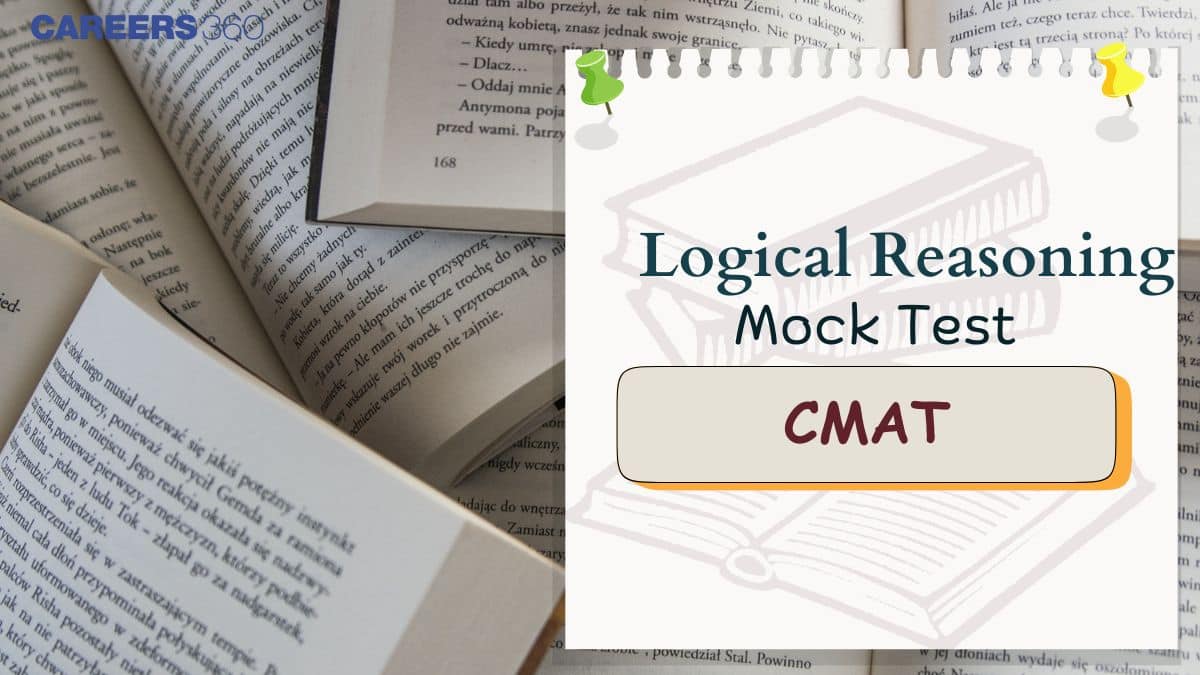
Introduction to CMAT Logical Reasoning
The CMAT Logical Reasoning section is an important section that tests students' logical and analytical reasoning skills. CMAT Logical Reasoning Practice Questions 2026 can be analytical, verbal, or critical.
Some important points about this section are:
Total Questions: 20
Number per question: 4
Question type: Objective MCQ
Negative marking: -1 for every wrong answer
Sectional time limit: No
Mode of the Exam: Computer-Based Examination
In this article, we will discuss the importance of the CMAT mock test in Logical Reasoning preparation for CMAT and provide you with some important links to the CMAT 2026 Mock Test for Logical Reasoning section.
Importance of Logical Reasoning in CMAT 2026
20 out of 100 questions will come from this section in CMAT, which makes 20% of the overall marks. The questions from this section will be moderate to hard. Students can score good marks in this section with proper strategies.
These are the important topics in Logical Reasoning CMAT and the expected number of questions from these topics this year.
Topics | Expected number of questions |
Blood Relations | 2-3 |
Syllogisms | 2-3 |
Coding-decoding | 1-2 |
Number of Squares and Triangles | 2-3 |
Seating Arrangements | 2-3 |
Critical reasoning | 3-4 |
Overview of the CMAT Exam Structure
The CMAT exam will be conducted online and the questions will be objective MCQ questions with 5 options. The total time to complete these sections will be 180 minutes or 3 hours with no sectional time limit. The total marks for CMAT 2026 will be 400.
Section | Number of Questions |
20 | |
Language Comprehension | 20 |
Logical Reasoning | 20 |
General Awareness | 20 |
Innovation & Entrepreneurship | 20 |
What is a CMAT Logical Reasoning Mock Test?
CMAT Mock Test Series 2026 is created closely following the latest pattern and syllabus of the CMAT exam. There are many benefits of taking mock tests
Benefits of Taking Mock Tests for CMAT
Here are the benefits of attempting regular mock tests for CMAT.
Understanding question pattern: Mock tests are prepared closely following the real CMAT exam pattern and CMAT syllabus. So you will get an in-depth idea about the questions that will be asked in the real exam.
Time management skills: You can enhance your time management skills by giving regular mock tests. Try to complete all the questions within the allotted time to prepare for the exam efficiently.
Accuracy & Speed enhancement: Consistent practice of mock tests will increase your speed as well as accuracy. You can identify your weaker areas and improve them to not repeat those mistakes.
Boosting confidence: Giving full-length mock tests will also build your mental stamina to sit for 180 minutes in one sitting which is critical for performing well in the exam.
Tracking performance: Students can make a log of scores in mock tests to analyze their performance. Online platforms also provide a comparison of scores with fellow peers.
How Mock Tests Improve Logical Reasoning Skills
Regular practice of mock tests will improve students' logical reasoning skills.
Solving a variety of problems: Mock tests cover questions from all the topics, which will help students to get familiar with every type of question and approach problems with different techniques.
Problem-solving skills: Students will get different questions from the same topics in mock tests and develop different methods to solve them to save time.
Pattern recognition: Logical Reasoning questions often require identifying patterns and relationships. With regular attempts of mock tests, students will improve their pattern recognition skills and quickly spot sequences, analogies, and series patterns.
Identifying weaker sections: Mock tests help students to identify the most challenging sections. So they get enough time to work on those sections after creating a targeted study plan.
Key Features of CMAT Logical Reasoning Mock Tests
Some of the key features of the CMAT Logical Reasoning Practice Test 2026 are:
Comprehensive coverage of all the important logical reasoning topics
Simulation of the real exam environment.
Comprehensive Coverage of Logical Reasoning Topics
Mock tests cover all the relevant topics of Logical Reasoning for CMAT like Blood relations, seating arrangements, coding-decoding, series completion, counting figures, directions, logical puzzles, and syllogisms comprehensively. These questions also mimic the same difficulty level asked in CMAT from moderate to hard.
After attempting mock tests, students can check the solutions for understanding different methods and approaches.
Step-by-step solutions to the questions are also provided.
Real Exam Simulation Environment
Students can use these mock tests to replicate the actual exam environment. This will reduce the stress and anxiety during the actual exam as students will get accustomed to the settings beforehand. Timed mock tests will be very useful to sharpen time management skills which is very important in this section.
How to Access CMAT Logical Reasoning Mock Tests Online
Students need to search and identify the best mock test platforms, which is a hectic job. This section will make this process easier for the students.
Best Platforms for CMAT 2026 Mock Tests
Many platforms provide online mock tests for CMAT 2026. Careers360 is one of them. Careers360’s CMAT mock test series are created following the latest pattern and syllabus of CMAT along with detailed explanations, timed-based analysis, and performance tracking.
Steps to Register for Online Mock Tests
These are the steps to register for the Online Logical Reasoning Test for CMAT 2026.
Visit the platform and sign up with your registered email ID and phone number.
Provide necessary details like name, courses you like to choose, and sometimes academic details.
Attempt the free mock tests to understand the quality of the sets.
Choose the available mock test series.
Then purchase that test series using various payment methods.
Visit the dashboard and start practicing those mock tests.
CMAT Logical Reasoning Practice Questions for 2026
These are some of the logical reasoning practice questions from all the topics to help students identify the question types.
Types of Questions Included in Practice Tests
Important topics asked in the CMAT Logical Reasoning Preparation Test 2026 are mentioned below.
Syllogism | Coding-decoding | Direction test |
Blood Relations | Cause & Effects | Seating Arrangements |
Statements & Conclusions | Number series | Statements & Assumptions |
Non-verbal reasoning | Sequencing |
Sample Questions and Answers for Preparation
Blood Relations:
Directions: K is the daughter of S. S is married to G. A is the only grandson of M. G is the son of M. A has one daughter H who is the only granddaughter of S. How is K related to A?
Sister
Mother's mother
Daughter
Mother's sister
Solution: Correct Answer: A
Following the instructions of the question, the family tree will be –

Here, the quadrilateral represents the male, and the circular figure represents the female in the figure.
So, K is the sister of A.
Hence, the first option is correct.
Seating Arrangements:
Directions: Four friends A, B, C, and D are sitting in a coffee shop around a square table. A and B are sitting face to face. D is not sitting next to A but can see the facial expression of A. B is talking to C who is sitting opposite to him. Who is sitting together?
A and C
A and D
D and C
A and B
Solution: Correct Answer: A
According to the given information,
A and B are sitting face to face, i.e., A and B are sitting on opposite sides of the square table.
D is not sitting next to A but can see the facial expression of A, i.e., D and A are also on the opposite sides of the square table.
B is sitting opposite to C.
The figure that shows the arrangement is –
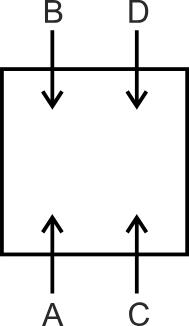
So, A and C are sitting together. Hence, the first option is correct.
Syllogisms:
Directions: Read the given statements and conclusions carefully. You have to take the given statements to be true even if they seem to be at variance from commonly known facts. You have to decide which conclusions logically follow/s from the given statements.
Statements:
All summers are hot.
Some hot is water.
No water is ice.
Conclusions:
(I) Some hot is summer.
(II) No ice is water.
Only conclusion (II) follows
Neither conclusion (I) nor (II) follows
Only conclusion (I) follows
Both conclusions (I) and (II) follow
Solution: Correct Answer: D
The possible Venn diagram, according to the given statements is as follows –
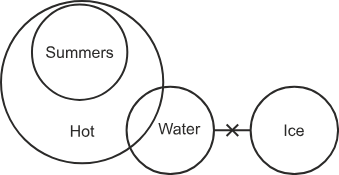
Let's analyze the conclusions –
Conclusion (I): Some hot is summer – From the diagram, it is clear that some parts of the circle representing hot lie outside the circle representing summer while some lie inside. So, some hot is summer. Therefore, this conclusion follows.
Conclusion (II): No ice is water – From the diagram, it is clear that there is a negative relation between water and ice. So, no ice is water is correct. Therefore, this conclusion follows.
So, both conclusions (I) and (II) follow. Hence, the fourth option is correct.
Number Series:
Directions: Which of the following four options will replace the question mark (?) in the following series?
149, ?, 114, 89, 59, 24
129
140
139
134
Solution: Correct Answer: D
Given:
149, ?, 114, 89, 59, 24
Subtract multiples of 5 starting from the third multiple to get the next term –
149 – (5 × 3) = 149 – 15 = 134;
134 – (5 × 4) = 134 – 20 = 114;
114 – (5 × 5) = 114 – 25 = 89;
89 – (5 × 6) = 89 – 30 = 59;
59 – (5 × 7) = 59 – 35 = 24
So, the missing number is 134. Hence, the fourth option is correct.
Counting the figure:
Directions: How many triangles are there in the given figure?
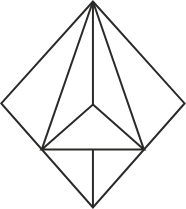
8
10
9
7
Solution: Correct Answer: C
The given figure can be labeled as shown below –
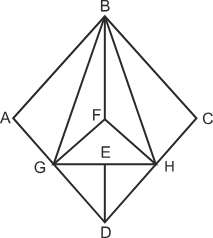
Now, in the above figure, there are 9 triangles. They are ABG, BGF, BHF, BHC, FGH, DEH, DEG, DGH, and BGH.
Hence, the third option is correct.
Coding-Decoding:
Directions: DGEC is related to KNLJ in a certain way based on the English alphabetical order. In the same way, NQOM is related to UXVT. To which of the following is ILJH related, following the same logic?
ORPN
PSQO
QTRP
PTRQ
Solution: Correct Answer: B
Given:
DGEC is related to KNLJ –
Add 7 to the place value of each letter of DGEC to obtain the required code –
D + 7 = K; G + 7 = N; E + 7 = L; C + 7 = J
Thus, DGEC is coded as KNLJ.
And, NQOM is related to UXVT –
N + 7 = U; Q + 7 = X; O + 7 = V; M + 7 = T
Thus, NQOM is coded as UXVT.
Similarly, follow the same pattern for ILJH –
I + 7 = P; L + 7 = S; J + 7 = Q; H + 7 = O
So, ILJH is coded as PSQO. Hence, the second option is correct.
Direction test:
Directions: Suresh walked 7 km East turned to his left and walked 4 km. He then turned to his right and walked 5 km. Finally, he again turned to his right and walked 4 km. In which direction is he now, from his starting point?
South
West
East
North
Solution: Correct Answer: C
Firstly, we will draw the diagram as per the given instructions –
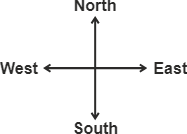
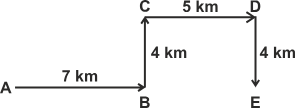
The starting point of Suresh is A and the endpoint is E.
So, Suresh is in the east direction from his starting point. Hence, the third option is correct.
Statements & Conclusions:
Directions: A statement is given followed by two conclusions I and II. You have to consider the statement to be true even if it seems to be at variance from commonly known facts. You have to decide which of the given conclusions, if any, follow from the given statements.
Statement: Tension is detrimental to physical and mental health.
Conclusions:
I. To be healthy one should be free from tension.
II. Mental health depends upon the tension one experiences.
Only I follows
Only II follows
Neither I nor II follows
Both I and II follow
Solution: Correct Answer: D
According to the above-given statement,
Conclusion I: To be healthy one should be free from tension.
This conclusion is true because if tension is detrimental to health, then being free from tension is necessary for maintaining health. Therefore, the conclusion I is valid.
Conclusion II: Mental health depends upon the tension one experiences.
This conclusion is true as the statement implies that tension negatively impacts mental health. So, mental health is influenced by the level of tension one experiences.
Therefore, both conclusion I and conclusion II follow. Hence, the fourth option is correct.
Strategies for Effective Preparation for CMAT Logical Reasoning
Time management should be one of the main focuses during preparation for the Logical Reasoning section in CMAT.
Time Management Tips During Mock Tests
These are some of the important time management skills that students can use and fine-tune during the mock tests.
Give priority to easier questions: Attempt the questions that are relatively easier and familiar to you and solve them quickly. This will save you time which you can use for complex questions.
Skip tough questions: Do not overspend more than 2-3 minutes on any question. Skip them for now and return to them later if time permit
Attention to question reading: Read the question carefully and note down key points, patterns, and methods. Sometimes questions consist of irrelevant information. Learn to segregate them from vital points.
Elimination method: Scan the options and cancel out obvious wrong options. If you are unsure about the answer, take an educated guess. You can also try back-calculation using the remaining options if there is time.
Focus on important words: It is very important to pay attention to important terms like:
All, some, none
Only and Only If
Unless, Not, and Definitely
Negative Prefixes like un-, dis-, non-, etc.
Factual interpretation of information is not always sufficient to answer these kinds of questions.
Analyzing Your Performance: Tracking Progress
Analyzing the mock tests after attempting them is very crucial to track your progression.
After attempting the mock tests, review thoroughly to identify the reason for the wrong answers and unanswered questions. Mark the categories where the most negative markings are happening and devise a plan to improve them.
If it is a logical error, then revise the basic concepts again and test yourself after 1 week of attempting a topic-wise test.
If the error is because of misinterpretation of the question, then practice more of those types of questions to easily identify the keywords or terms.
If you are taking too much time on any specific types of questions, then look for alternative methods to solve those problems in a quicker time.
Check the reason for the unanswered questions to understand. If it is for the time constraints or the difficulty level of the question.
Set yourself a goal for the next mock test to improve accuracy and performance.
CMAT 2026 Mock Test Series Overview
In this section, we will provide students with links to free mock tests and compare different mock test sites so that students can choose their ideal sets on their own.
Recommended Mock Test Series for Optimal Preparation
These are some links to the mock test series for optional preparation.
Comparison of Different Mock Test Series
Key aspects Ideal Mock test series | Careers360 Mock test series |
Content Coverage | These mock tests cover all the important logical reasoning topics like puzzles, arrangements, blood relations, syllogisms, and critical reasoning. |
Question Quality and Difficulty | The question quality and difficulty level closely mimic the actual CMAT questions. |
Detailed Solutions and Explanations | There are detailed step-by-step solutions for every question with alternative solution methods. Expert tips are also provided. |
Performance Analytics | These tests also provide in-depth performance reports including accuracy, speed, and section-wise strengths and weaknesses. |
Adaptive Testing | After analyzing your progression in tests, this platform also provides targeted practice sets for improvement in certain areas. |
Peer Comparison | Shows you the total numbers and rankings of fellow peers who have attempted the same test. |
Common Logical Reasoning Topics in CMAT
Common Logical Reasoning topics in CMAT are:
Puzzles
Seating arrangements
Syllogisms
Logical deductions
Puzzles and Seating Arrangements
These questions can be of different types like:
Linear arrangements
Circular arrangements
Complex arrangements
Grid-based puzzles
Tips:
Students should use different visualization techniques like diagrams, and charts to understand the data better.
Break down complex clues into smaller and more manageable parts.
Practice lots of these types of questions as these are very time-consuming questions.
Allot time limits for these questions like 3-4 minutes for each question.
Syllogisms and Logical Deductions
These questions involve:
Syllogisms
Venn diagrams
Identifying valid inferences from a series of statements or premises.
Tips:
Practice common patterns in syllogisms and their rules.
Practice using Venn diagrams to solve syllogism questions quickly and accurately.
Do not overthink these questions and avoid adding unnecessary data on your own. Work with the data that are given.
Tips for Mastering Logical Reasoning for CMAT 2026
In this section of the article, we will provide the idea of which are the best books topic-wise to students and discuss which preparation type is better: solo or group study.
Study Materials and Resources
These are the names of the best books topic-wise.
Topic | Name of the Book |
Seating Arrangements & Puzzles | R.S. Aggarwal and Arun Sharma’s books |
Coding-Decoding | R.S. Aggarwal and Arihant Experts |
Syllogisms | R.S. Aggarwal, M.K. Pandey, and Arihant Experts |
Logical Sequences and Patterns | Arihant Experts and Nishit Sinha’s books |
Group Study vs. Solo Preparation
These are the pros and cons of solo and group studies. Students can decide on their own which preparation type they want to choose.
Solo Preparation | Group Study | |
Pros |
|
|
Cons |
|
|
In the end, we can suggest that a balanced approach of both can be a good option. Students can learn all basic concepts and build a foundation on their own from books and study materials. Then they can join groups or forums to clear their doubts on complex or difficult topics.
Good luck- you can achieve your dreams.
Additional Resources for CMAT 2026
Students need to learn the basics from books and then start practising them in online mock tests.
Recommended Books for Logical Reasoning
These are some of the recommended books for the CMAT Logical Reasoning section.
"A Modern Approach to Logical Reasoning" by R.S. Aggarwal
"Analytical Reasoning" by M.K. Pandey
"Logical Reasoning and Data Interpretation for CAT" by Nishit Sinha
"How to Prepare for Logical Reasoning for CAT" by Arun Sharma
"CMAT Logical Reasoning" by Arihant Experts
Popular Courses and Specializations
List of colleges accepting CMAT
Browse Bschool Colleges by State
Questions related to CMAT
On Question asked by student community
Hello aspirant,
One of the most important things to do when beginning a strategy exam preparation is to grasp the CMAT syllabus 2025. Candidates can make an efficient study plan that helps them cover every topic in detail by consulting the CMAT exam syllabus.
To know the detailed syllabus you can visit our website by clicking on the link given below.
https://bschool.careers360.com/articles/cmat-syllabus
Thank you
Hope this information helps you.
An 80 percentile CMAT score is a decent score, but whether you can secure admission to IMS depends on several factors:
- Specific IMS Campus: There are multiple IMS campuses with varying admission criteria and cut-offs.
- Program Offered: The program you're targeting (PGDM, MBA, etc.) will have different eligibility requirements.
- Category: Your category (General, OBC, SC, ST) will influence your chances.
- Competition: The overall competition for that particular year and program will determine the final cut-off.
While an 80 percentile score increases your chances, it's essential to check the specific cut-offs for your desired IMS campus and program. Additionally, consider other factors like work experience, academic background, and GD/PI performance, as they might play a role in the final selection.
To improve your chances, research different IMS campuses, understand their admission process, and prepare well for the subsequent selection rounds.
hope this helps you!!
Hello student,
With a CMAT score of 70 percentile in the EWS category and being a Madhya Pradesh (MP) domicile, you may have a chance of getting into some Institutes of Management Studies (IMS) in MP, though admission can be competitive. Here are a few points to consider:
1. Previous Year Cutoffs:
-
Generally, IMS have varying cutoffs based on the course and the number of applicants. Check the previous year's cutoffs for the specific IMS you're targeting, as this will give you a clearer picture of your chances.
2. EWS Category:
-
Being in the EWS category may provide you with some advantage in terms of lower cutoff requirements in certain institutes, which could enhance your chances of admission.
3. Counseling Process:
-
Keep an eye on the counseling process and any updates regarding seat allocations. Some IMS might have management quota seats that could also be an option.
4. Other Admission Criteria:
-
Besides CMAT scores, some institutes may consider other factors like academic performance, work experience, and group discussions/interviews.
Recommendations:
-
Apply to Multiple Colleges
: Don’t limit yourself to just one or two IMS; consider applying to several to increase your chances.
- Stay Updated : Regularly check the official websites of the IMS for any announcements regarding admissions and counseling schedules.
In summary, while admission with a 70 percentile CMAT score can be competitive, your chances can improve due to your EWS category and MP domicile status.
I hope this answer helps you. If you have more queries then feel free to share your questions with us we will be happy to assist you.
Thank you and wishing you all the best for your bright future.
Hello student,
With a 72 percentile in CMAT, you have a chance at getting into some decent B-schools, though top-tier institutions might be a bit out of reach. Here’s a breakdown of what you can aim for:
1. Tier 2 & 3 Colleges:
-
Colleges like
:
- Indira Institute of Management, Pune
- IES Management College, Mumbai
- Prestige Institute of Management, Indore
-
Institute of Public Enterprise, Hyderabad
-
These institutes may have cutoffs around your percentile, and they offer good value, especially with decent placement records.
2. State-Level B-Schools:
-
You can explore state-affiliated MBA colleges that accept CMAT scores in your percentile range. Institutions from states like Maharashtra, Madhya Pradesh, and Gujarat may be a good fit.
3. Focus on Specializations:
-
Depending on your area of interest (e.g., finance, marketing, HR), some colleges may have stronger programs in specific domains, even if they are not top-ranked overall.
4. Check Counseling and Quota Options:
- Some colleges might have management or state quota seats that could work in your favor.
Next Steps :
- Research individual college cutoffs from last year.
- Attend counseling sessions for personalized advice.
Though 72 percentile isn't in the top tier, with smart choices, you can still land a solid MBA seat!
I hope this answer helps you. If you have more queries then feel free to share your questions with us we will be happy to assist you.
Thank you and wishing you all the best for your bright future.
Hello Dhara,
The
ACPC (Admission Committee for Professional Courses)
merit rank is determined based on a combination of your academic performance and entrance exam scores. Here’s a breakdown of how it typically works:
1. Components of Merit Calculation
:
-
Class 10 Marks
: Generally, the performance in Class 10 may have a lesser weightage, as the focus is primarily on higher secondary and graduation scores.
-
Class 12 Marks
: This usually carries significant weight. Your aggregate percentage in subjects relevant to your desired course is crucial.
-
BCA Marks
: For MBA admissions, your BCA aggregate score is essential, particularly your performance in core subjects.
-
CMAT Score
: Your CMAT score will heavily influence your merit rank. The higher the score, the better your chances for a favorable rank.
2. Formula for Calculation :
-
While the specific formula can vary, the general approach often looks like this:
-
Weightage
: Class 12 (around 40-50%), BCA (around 20-30%), CMAT score (around 30-40%).
-
Your overall score is calculated by applying these weightages to each component.
3. Normalization :
-
Weightage
: Class 12 (around 40-50%), BCA (around 20-30%), CMAT score (around 30-40%).
-
Some committees apply normalization techniques to ensure that scores from different boards and exams are comparable.
4. Final Merit List :
-
After calculating the scores based on the above components, the ACPC will prepare a
merit list
that ranks candidates according to their final scores.
Tips :
-
Check Official Guidelines
: Since criteria can vary yearly, always refer to the official ACPC website or their latest admission brochure for specific details regarding weightages and calculation methods.
- Focus on Performance : To improve your merit rank, focus on excelling in your CMAT exam and maintaining high marks in your 12th and BCA courses.
In summary, your merit rank in ACPC will be a composite of your academic scores and CMAT performance, with a focus on your 12th and BCA marks as key components.
I hope this answer helps you. If you have more queries then feel free to share your questions with us we will be happy to assist you.
Thank you and wishing you all the best for your bright future.
